Application of Graphite Electrodes Prepared from Waste Zinc−Carbon Batteries for Electrochemical Detection of Xanthine
Abstract
1. Introduction
2. Experimental
3. Results and Discussion
3.1. XRD Characterization
3.2. Electrochemical Behavior of the Xanthine
3.3. Effect of pH
3.4. Effect of Scan Rate
3.5. Oxidation of Xanthine
3.6. Differential Pulse Voltammetry Determination of Xanthine on Graphite Electrode
| Electrode | Method | Analyte | Media | LOD | Linear Range | Real Sample | Reference |
|---|---|---|---|---|---|---|---|
| Pt@MIL-101(Cr)/GCE | DPV | XA + UA, HX, DA | 0.1 M PBS, pH 7 | 0.42 μM | 0.5–162 μM | human serum | [45] |
| Poly(l-methionine) modified GCE | DPV | XA + UA, HX | 0.1 M PBS, pH 7.2 | 0.004 μM | 0.02–0.1 μM | blood serum sample | [46] |
| NiO/MWCNT/NNaM/PGE | DPV | XA + TP, TB | BR, pH 2.0 | 0.077 μM | 0.5–150 μM | chocola-te black tea human urine | [47] |
| MWCNT-AuNP-CCE | DPV | XA + UA, CF | 0.1 M PBS, pH 6.0 | 63 nM | 2.5–300 μM | human serum urine | [48] |
| KH/GTD/XOD/CHT modified GCE | DPV | XA | 0.1 M PBS, pH 7 | 0.0215 μmol/L | 0.5–18 μmol/L | [49] | |
| CNF-CPE | DPV | XA + HX, UA | 0.1 M PBS, pH 6.0 | 0.5 μM | 1.5 μM to 218 μM | urine samples | [50] |
| DPV | XA + UA, HX | 0.1 M PBS, pH 7.0 | 0.083 μmol/L | 0.5–140 μmol/L | human serum | ||
| P(L-Arg)/GPE | DPV | XA + UA | 0.1 M PBS pH 6.0 | 10.36 × 10−7 M | 10 to 138 μmol/L 139 to 330 μmol/L | fish meat | [51] |
| PTA/CeO2@Pt/GCE | DPV | XA + CF | 0.2 M PBS pH 5.0 | 10 nM | 0.1–100 μM | urine blood | [7] |
| P-g-C3N4@ GCE | DPV | XA + HX, UA | PBS pH 7.2 | 0.93 μM | 15–40 μM | Sea food | [8] |
| CuO nanostructures prepared with 1 mL sugar molasses/GCE | DPV | XA | 0.1 M BR, pH 5 | 0.264 μM | 1.0–12.0 μM | fish | [9] |
| GCE/ACCP | DPV | XA + UA | 0.1 M BR, pH 4 | 0.547 μM | 5–10 μM, 10–49.5 μM, and 49.5–327.1 μM | urine | [6] |
| 0.08 Co/UiO-66/GCE | DPV | XA + HA | 0.1 M PBS, pH 8.0 | 0.24 μM | 1–900 μM | meat | [10] |
| p(g42T-TT)-based enzymatic biosensors | DPV | XA | PBS | 27.4 nM | 0.5–1 μM | Rohu Fish Extract | [32] |
| Graphite electrode | DPV | XA | BR, pH 3 | 7.86·10−8 M | 5·10−7–1·10−4 M | Beer, Cola drink | This research |
3.7. Interference Studies
3.8. Real Sample Analysis
3.9. Stability and Repeatability of the Graphite Electrode
4. Conclusions
Author Contributions
Funding
Institutional Review Board Statement
Informed Consent Statement
Data Availability Statement
Conflicts of Interest
References
- Jiwanti, P.K.; Wardhana, B.Y.; Sutanto, L.G.; Chanif, F.A. Review on Carbon-based Electrodes for Electrochemical Sensor of Quinolone Antibiotics. ChemistrySelect 2022, 7, e202103997. [Google Scholar] [CrossRef]
- Sharma, V.; Jayaprakash, G.K. Fabrications of electrochemical sensors based on carbon paste electrode for vitamin detection in real samples: Review Paper. J. Electrochem. Sci. Eng. 2022, 12, 421–430. [Google Scholar] [CrossRef]
- Pratiwi, N.H.; Azis, M.Y.; Satiyanto, H. Review of Developments of Modified Carbon-Based Electrodes on ElectrochemicalSensors for Water Environment Monitoring. Anal. Bioanal. Chem. Res. 2024, 11, 91–109. [Google Scholar]
- Mostafiz, B.; Bigdeli, S.A.; Banan, K.; Afsharara, H.; Hatamabadi, D.; Mousavi, P.; Hussain, C.M.; Keçili, R.; Ghorbani-Bidkorbeh, F. Molecularly imprinted polymer-carbon paste electrode (MIP-CPE)-based sensors for the sensitive detection of organic and inorganic environmental pollutants: A review. Trends Environ. Anal. Chem. 2021, 32, e00144. [Google Scholar] [CrossRef]
- Monisha, S.; Subhashri, M.; Devi, S.K.S.; Manju, V.; Kumar, A.S. Defective graphene-nanomaterials derived from banana-biomass for simultaneous electrochemical detection of xanthine, hypoxanthine, and uric acid: Insights from scanning electrochemical microscopy on edge and basal planes. Electrochim. Acta 2024, 497, 144515. [Google Scholar] [CrossRef]
- Somba, A.V.; Kamgaing, T.; Fotsop, C.G.; Deffo, G.; Nkuigoua, B.W.; Tagne, R.F.T.; Tajeu, K.Y.; Temgoua, R.C.T.; Njanja, E.; Tonlé, I.K. Preparation and Characterization of Alkali Activated Carbon Based Theobroma Cocoa Pods: Application for Electrochemical Determination of Xanthine in Fresh Fish Sample. ChemistrySelect 2024, 9, e202303250. [Google Scholar] [CrossRef]
- Yu, S.; Yue, Z.; Wang, X.; Zhang, S.; Zhou, Z.; Zhang, L.; Ma, Y. PTA/CeO2@Pt-based electrochemical sensors to detect xanthine and uric acid, and evaluate fish freshness. Chem. Eng. J. 2024, 490, 151646. [Google Scholar] [CrossRef]
- Sakthivel, A.; Alwarappan, S. Phosphorous Doped Graphitic Carbon Nitride (P-g-C3N4) as an Electrochemical Platform for the Simultaneous Detection of Xanthine and Caffeine. ChemNanoMat 2024, 10, e202400327. [Google Scholar] [CrossRef]
- Waryani, B.; Tahira, A.; Saeed, S.; Bibi, A.; Bhatti, M.A.; Siddiqui, A.; Mahar, I.A.; Parveen, M.; Dawi, E.; Shah, A.A.; et al. Utilizing CuO nanostructures derived from sugar molasses for the detection of xanthine. J. Mater. Sci. Mater. Electron. 2024, 35, 232. [Google Scholar] [CrossRef]
- Nguyen, V.T.; Manh, T.D.; Man, N.Q.; Thoa, P.T.H.; Khieu, D.Q. Electrochemical detection of uric acid and xanthine in human urine using the Co/UiO-66 modified glassy carbon electrode. J. Appl. Electrochem. 2024, 54, 2361–2376. [Google Scholar] [CrossRef]
- Yang, L.; Niu, Y.; Wang, S.; Shi, Y.; Wang, Y. Flower-like nickel-doped tin disulfide multi-walled carbon nanotube-based electrochemical sensor for the detection of xanthine and hypoxanthine. J. Food Compos. Anal. 2024, 135, 106586. [Google Scholar] [CrossRef]
- Barsan, M.M.; Ghica, M.E.; Brett, C.M.A. Electrochemical sensors and biosensors based on redox polymer/carbon nanotube modified electrodes: A review. Anal. Chim. Acta 2015, 881, 1–23. [Google Scholar] [CrossRef]
- Wang, J. Carbon-Nanotube Based Electrochemical Biosensors: A Review. Electroanalysis 2005, 17, 7–14. [Google Scholar] [CrossRef]
- Ramachandran, R.; Mani, V.; Chen, S.M.; Saraswathi, R.; Lou, B.S. Recent Trends in Graphene based Electrode Materials for Energy Storage Devices and Sensors Applications. Int. J. Electrochem. Sci. 2013, 8, 11680–11694. [Google Scholar] [CrossRef]
- Pumera, M.; Ambrosi, A.; Bonanni, A.; Chng, E.L.K.; Poh, H.L. Graphene for electrochemical sensing and biosensing. Trends Anal. Chem. 2010, 29, 954–965. [Google Scholar] [CrossRef]
- Huang, X.; Zeng, Z.; Zhanxi Fan, Z.; Liu, J.; Zhang, H. Graphene-Based Electrodes. Adv. Mater. 2012, 24, 5979–6004. [Google Scholar] [CrossRef] [PubMed]
- Zouaoui, F.; Menassol, G.; Ducros, C.; Mailley, P.; Thomas, Y. Electrochemical sensors based on amorphous carbon electrode: A review. Microchem. J. 2025, 209, 112650. [Google Scholar] [CrossRef]
- Walcarius, A. Electrocatalysis, sensors and biosensors in analytical chemistry based on ordered mesoporous and macroporous carbon-modified electrodes. Trends Anal. Chem. 2012, 38, 79–97. [Google Scholar] [CrossRef]
- Tasić, Ž.Z.; Petrović Mihajlović, M.B.; Radovanović, M.B.; Simonović, A.T.; Dragana, V.; Medić, D.V.; Antonijević, M.M. Electrochemical determination of L-tryptophan in food samples on graphite electrode prepared from waste batteries. Sci. Rep. 2022, 12, 5469. [Google Scholar] [CrossRef]
- Palisoc, S.T.; Cansino, F.E.J.; Dy, I.M.O.; Razal, C.F.A.; Reyes, K.C.N.; Racines, L.R.; Natividad, M.T. Electrochemical determination of tannic acid using graphite electrodes sourced from waste zinc-carbon batteries. Sens. Bio-Sens. Res. 2020, 28, 100326. [Google Scholar] [CrossRef]
- Santos, C.S.; Pawlak, V.G.; Oliveira, R.D.; Fujiwara, S.T.; Pessôa, C.A. Carbon Graphite Obtained of Zinc-Carbon Exhausted Batteries Applied as Electrode in Electrochemical Sensors. Rev. Virtual Quim. 2018, 11, 275–296. [Google Scholar] [CrossRef]
- El Naggar, M.R.; Fahmy, H.M.; El Nashar, R.M. Decoration of recycled battery graphite functionalized with gold nanoparticles/poly(nicotinic acid) for detection of bifenazate pesticide in tea and food samples. Microchem. J. 2024, 206, 111519. [Google Scholar] [CrossRef]
- Abd El-Nasser, A.G.; Metwally, M.G.; Shoukry, A.A.; El Nashar, R.M. Application of recycled battery graphite decorated with poly hippuric acid/ multiwalled carbon nanotubes as an ecofriendly sensor for serotonin. Sci. Rep. 2024, 14, 29304. [Google Scholar] [CrossRef] [PubMed]
- Alva, S.; Septyanda, P.; Burhanudin, A.; Khaerudini, D.S.; Nurul, S.; Jenie, A.; Sundari, R.; Suhud, K. Development of Nitrate-Ion Selective Electrode (NO3-ISE) Based on Carbon from Disposal Battery. ECS J. Solid State Sci. Technol. 2023, 12, 057010. [Google Scholar] [CrossRef]
- Palisoc, S.; Vitto, R.I.M.; Natividad, M. Determination of Heavy Metals in Herbal Food Supplements using Bismuth/Multi-walled Carbon Nanotubes/Nafion modified Graphite Electrodes sourced from Waste Batteries. Sci. Rep. 2019, 9, 18491. [Google Scholar] [CrossRef]
- Moulya, K.P.; Manjunatha, J.G.; Aldossari, S.A.; Mohammad, S.; Ataollahi, N. Recycled Battery Carbon Composite Sensor for the Electrochemical Analysis of the Neurotransmitter Dopamine. Top. Catal. 2025. [Google Scholar] [CrossRef]
- Kabir, M.H.; Pabel, M.Y.; Bristy, N.T.; Salam, M.A.; Bashar, M.S. Sabina Yasmin from e-waste to eco-sensors: Synthesis of reduced graphene oxide/ZnO from discarded batteries for a rapid electrochemical bisphenol A sensor. RSC Adv. 2024, 14, 36073–36083. [Google Scholar] [CrossRef]
- Silva, R.M.; Sperandio, G.H.; da Silva, A.D.; Okumura, L.L.; da Silva, R.C.; Moreira, R.P.L.; Silva, T.A. Electrochemically reduced graphene oxide films from Zn C battery waste for the electrochemical determination of paracetamol and hydroquinone. Mikrochim. Acta 2023, 190, 273. [Google Scholar] [CrossRef]
- Kapri, A.; Pant, S.; Gupta, N.; Nain, S. Recent Advances in the Biological Significance of Xanthine and its Derivatives: A Review. Pharm. Chem. J. 2022, 56, 461–474. [Google Scholar] [CrossRef]
- Dervisevic, M.; Dervisevic, E.; Şenel, M. Recent progress in nanomaterial-based electrochemical and optical sensors for hypoxanthine and xanthine. A review. Microchim. Acta 2019, 186, 749. [Google Scholar] [CrossRef]
- Abu-Hashem, A.A.; Hakami, O.; El-Shazly, M.; El-Nashar, H.A.S.; Yousif, M.N.M. Caffeine and Purine Derivatives: A Comprehensive Review on the Chemistry, Biosynthetic Pathways, Synthesis-Related Reactions, Biomedical Prospectives and Clinical Applications. Chem. Biodivers. 2024, 21, e202400050. [Google Scholar] [CrossRef]
- Lin, Y.; Kroon, R.; Zeglio, E.; Herland, A. P-type accumulation mode organic electrochemical transistor biosensor for xanthine detection in fish. Biosens. Bioelectron. 2025, 269, 116928. [Google Scholar] [CrossRef]
- Pundir, C.S.; Devi, R. Biosensing methods for xanthine determination: A review. Enzyme Microb. Technol. 2014, 57, 55–62. [Google Scholar] [CrossRef]
- Ahlawat, J.; Sharma, M.; Pundir, C.S. Advances in xanthine biosensors and sensors: A review. Enzyme Microb. Technol. 2024, 174, 110377. [Google Scholar] [CrossRef] [PubMed]
- Moutcine, A.; Laghlimi, C.; Ziat, Y.; El Bahraoui, S.; Belkhanchi, H.; Jouaiti, A. Advanced design of chemically modified electrodes for the electrochemical analysis of uric acid and xanthine. J. Pharm. Biomed. Anal. 2025, 253, 116536. [Google Scholar] [CrossRef] [PubMed]
- Lan, D.; Zhang, L. Electrochemical synthesis of a novel purine-based polymer and its use for the simultaneous determination of dopamine, uric acid, xanthine and hypoxanthine. J. Electroanal. Chem. 2015, 757, 107–115. [Google Scholar] [CrossRef]
- Masood, Z.; Muhammad, H.; Tahiri, I.A. Comparison of Different Electrochemical Methodologies for Electrode Reactions: A Case Study of Paracetamol. Electrochem 2024, 5, 57–69. [Google Scholar] [CrossRef]
- Vishwanathan, M.S.; Swamy, B.E.K.; Vishnumurthy, K.A. Iron Oxide Modified Carbon Paste Electrode Sensor for Guanine and Dopamine: A Voltammetric Technique. Anal. Bioanal. Electrochem. 2023, 15, 444–457. [Google Scholar]
- Zhou, Y.; Tang, W.; Wang, J.; Zhang, G.; Chai, S.; Liang Zhang, L.; Liu, T. Selective determination of dopamine and uric acid using electrochemical sensor based on poly(alizarin yellow R) film-modified electrode. Anal. Methods 2014, 6, 3474–3481. [Google Scholar] [CrossRef]
- Jesny, S.; Kumar, K.G. Non-enzymatic Electrochemical Sensor for the Simultaneous Determination of Xanthine, its Methyl Derivatives Theophylline and Caffeine as well as its Metabolite Uric Acid. Electroanalysis 2017, 29, 1828–1837. [Google Scholar] [CrossRef]
- Ibrahim, M.S.; Temerk, Y.M.; Kamal, M.M.; Ahmed, G.A.-W.; Ibrahim, H.S.M. Ultra-Sensitive Anodic Striping Voltammetry for the Determination of Xanthine at a Glassy Carbon Electrode. Microchim. Acta 2004, 144, 249–256. [Google Scholar] [CrossRef]
- Chelmea, L.; Badea, M.; Ioan Scarneciu, I.; Moga, M.A.; Dima, L.; Restani, P.; Murdaca, C.; Ciurescu, D.; Gaman, L.E. New Trends in Uric Acid Electroanalysis. Chemosensors 2023, 11, 341. [Google Scholar] [CrossRef]
- Radovanović, M.B.; Petrović Mihajlović, M.B.; Simonović, A.T.; Tasić, Ž.; Antonijević, M.M. Electrochemical Detection of Cadmium Using a Bismuth Film Deposited on a Brass Electrode. Sensors 2025, 25, 159. [Google Scholar] [CrossRef] [PubMed]
- Kaczmarska, K.; Brycht, M.; Leniart, A.; Skrzypek, S. Differential pulse voltammetric determination of an immunosuppressive drug teriflunomide on an edge plane pyrolytic graphite electrode. RSC Adv. 2017, 7, 26028. [Google Scholar] [CrossRef]
- Zhang, L.; Li, S.; Xin, J.; Ma, H.; Pang, H.; Tan, L.; Wang, X. A non-enzymatic voltammetric xanthine sensor based on the use of platinum nanoparticles loaded with a metal-organic framework of type MIL-101(Cr). Application to simultaneous detection of dopamine, uric acid, xanthine and hypoxanthine. Microchim. Acta 2019, 186, 9. [Google Scholar] [CrossRef] [PubMed]
- Ojani, R.; Alinezhad, A.; Abedi, Z. A highly sensitive electrochemical sensor for simultaneous detectionof uric acid, xanthine and hypoxanthine based on poly(l-methionine) modified glassy carbon electrode. Sens. Actuators B Chem. 2013, 188, 621–630. [Google Scholar] [CrossRef]
- Fitoz, A.; Yazan, Z.; Önal, M. Simultaneous Trace Electrochemical Determination of Xanthine Theophylline and Theobromine with a Novel Sensor Based on a Composite Including Metal Oxide Nanoparticle Multi-walled Carbon Nanotube and Nano- Na-montmorillonite Clay. Electroanalysis 2021, 33, 2226–2234. [Google Scholar] [CrossRef]
- Ferrag, C.; Noroozifar, M.; Kerman, K. Thiol functionalized carbon ceramic electrode modified with multi-walled carbon nanotubes and gold nanoparticles for simultaneous determination of purine derivatives. Mater. Sci. Eng. C 2020, 110, 110568. [Google Scholar] [CrossRef]
- Liu, Y.; Li, W.; Wei, C.; Lü, L. Preparation of a Xanthine Sensor Based on the Immobilization of Xanthine Oxidase on a Chitosan Modified Electrode by Cross-linking. Chin. J. Chem. 2012, 30, 1601–1604. [Google Scholar] [CrossRef]
- Tang, X.; Liu, Y.; Hou, H.; You, T. A nonenzymatic sensor for xanthine based on electrospun carbon nanofibers modified electrode. Talanta 2011, 83, 1410–1414. [Google Scholar] [CrossRef]
- Bai, Z.K.; Zhang, Y.T.; Li, S.H.; Luo, H.X.A. Flexible Electrochemical Sensor Based on L-Arginine Modified Chemical Vapor Deposition Graphene Platform Electrode for Selective Determination of Xanthine. Chin. J. Anal. Chem. 2020, 48, 1149–1159. [Google Scholar] [CrossRef]
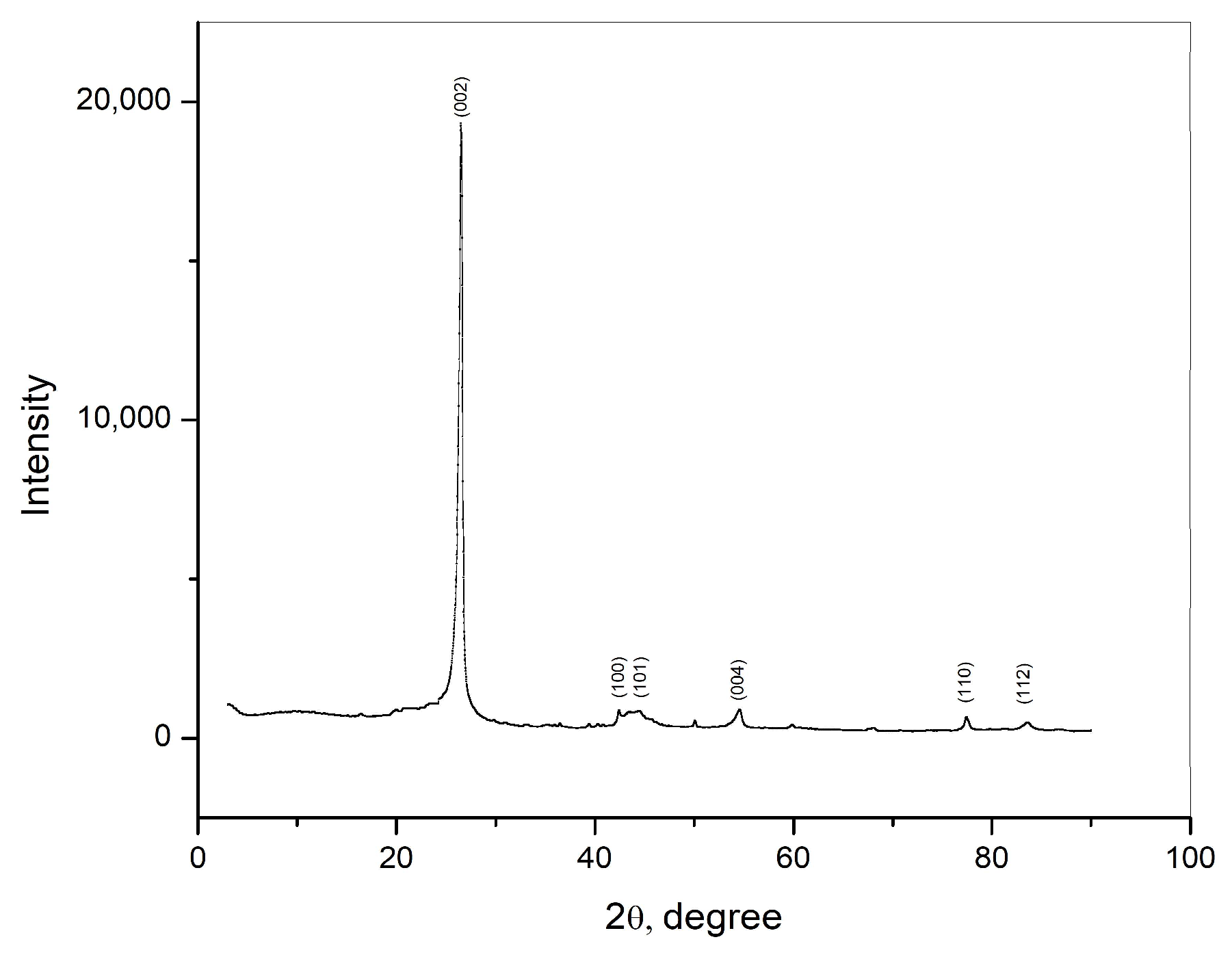
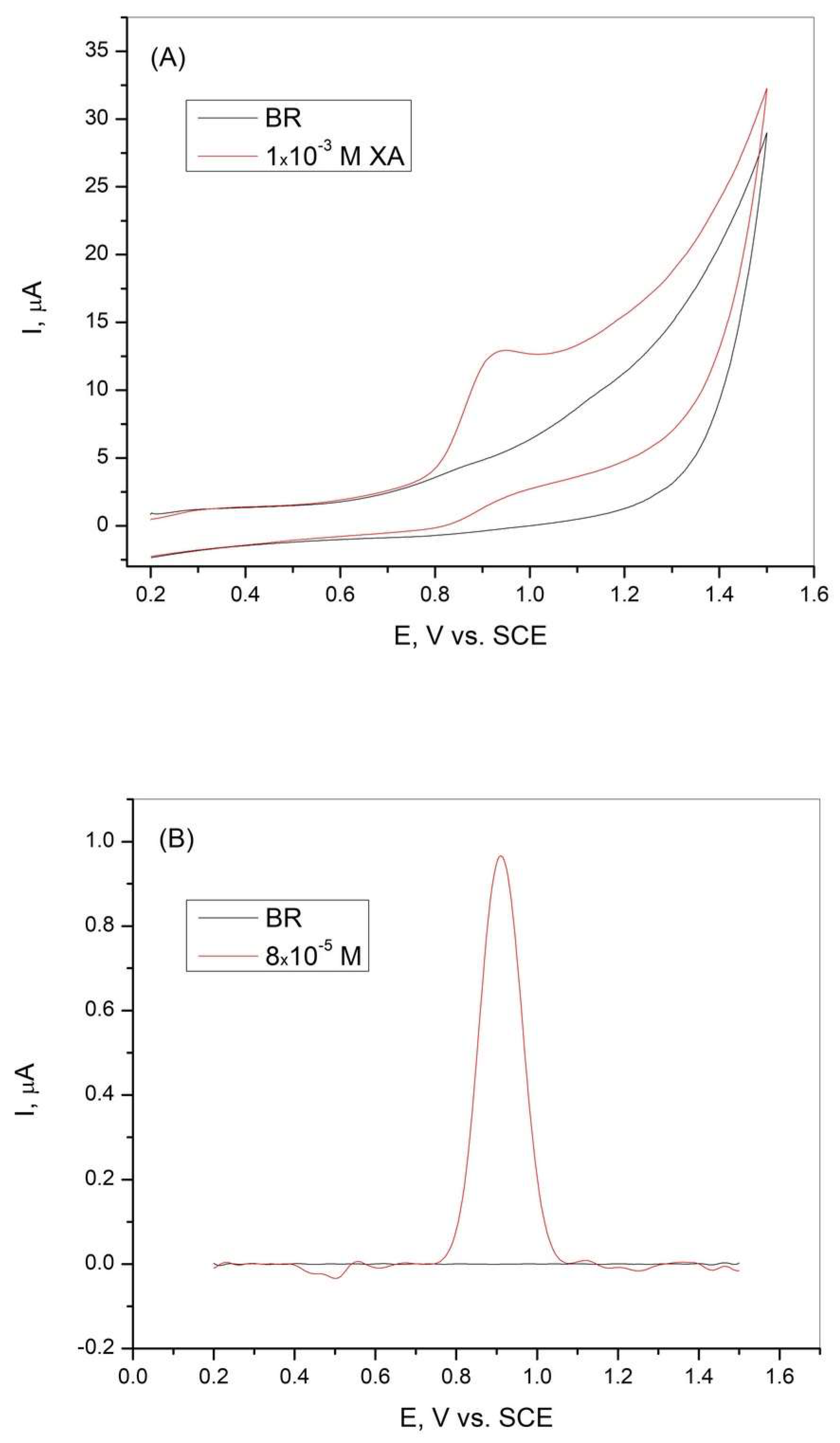

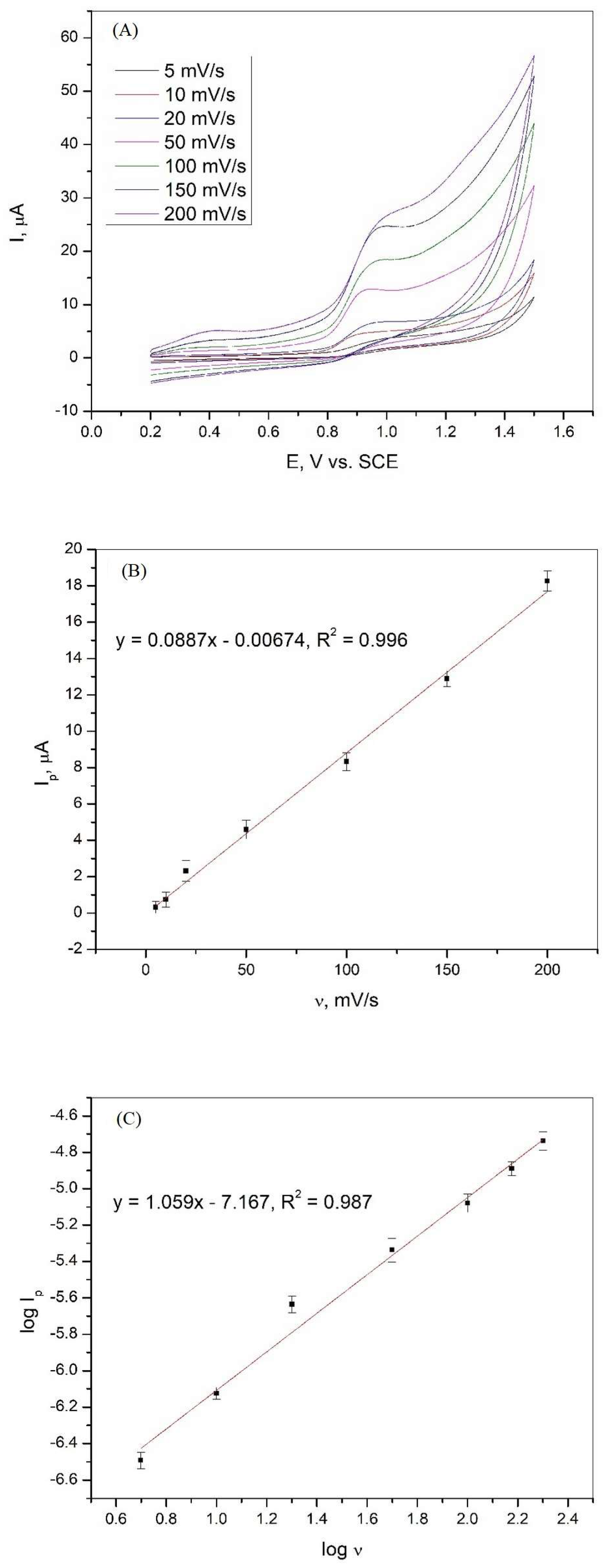

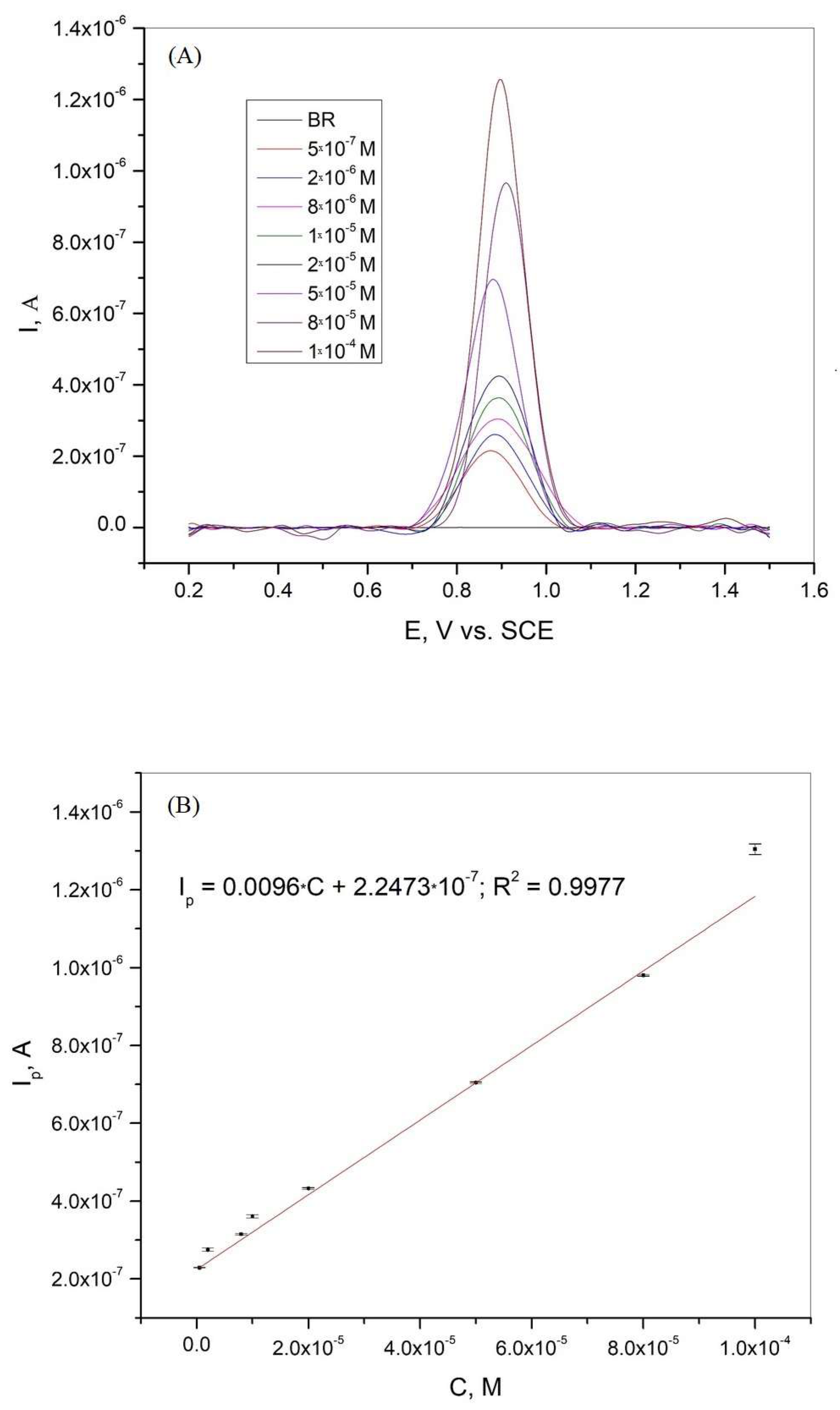
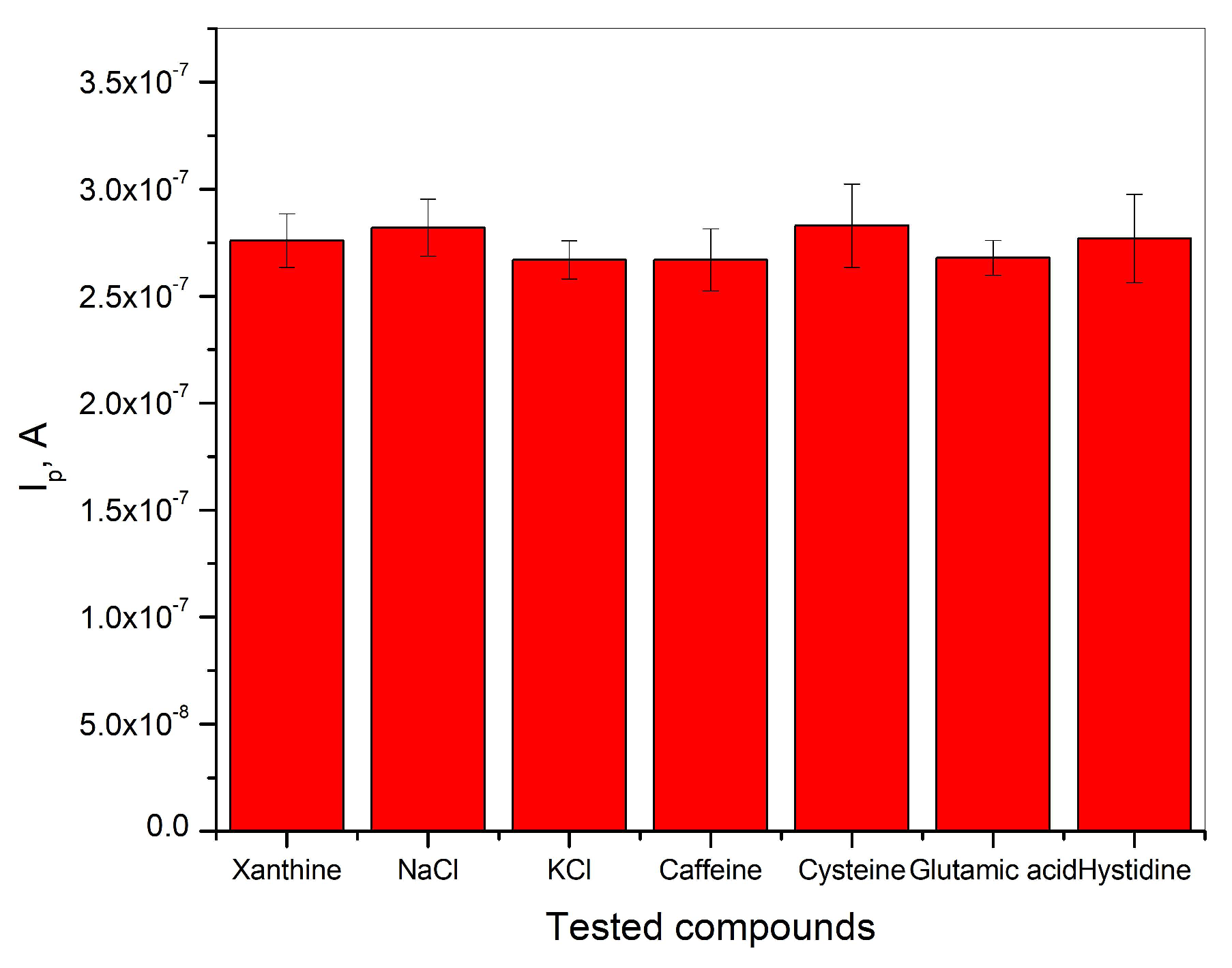
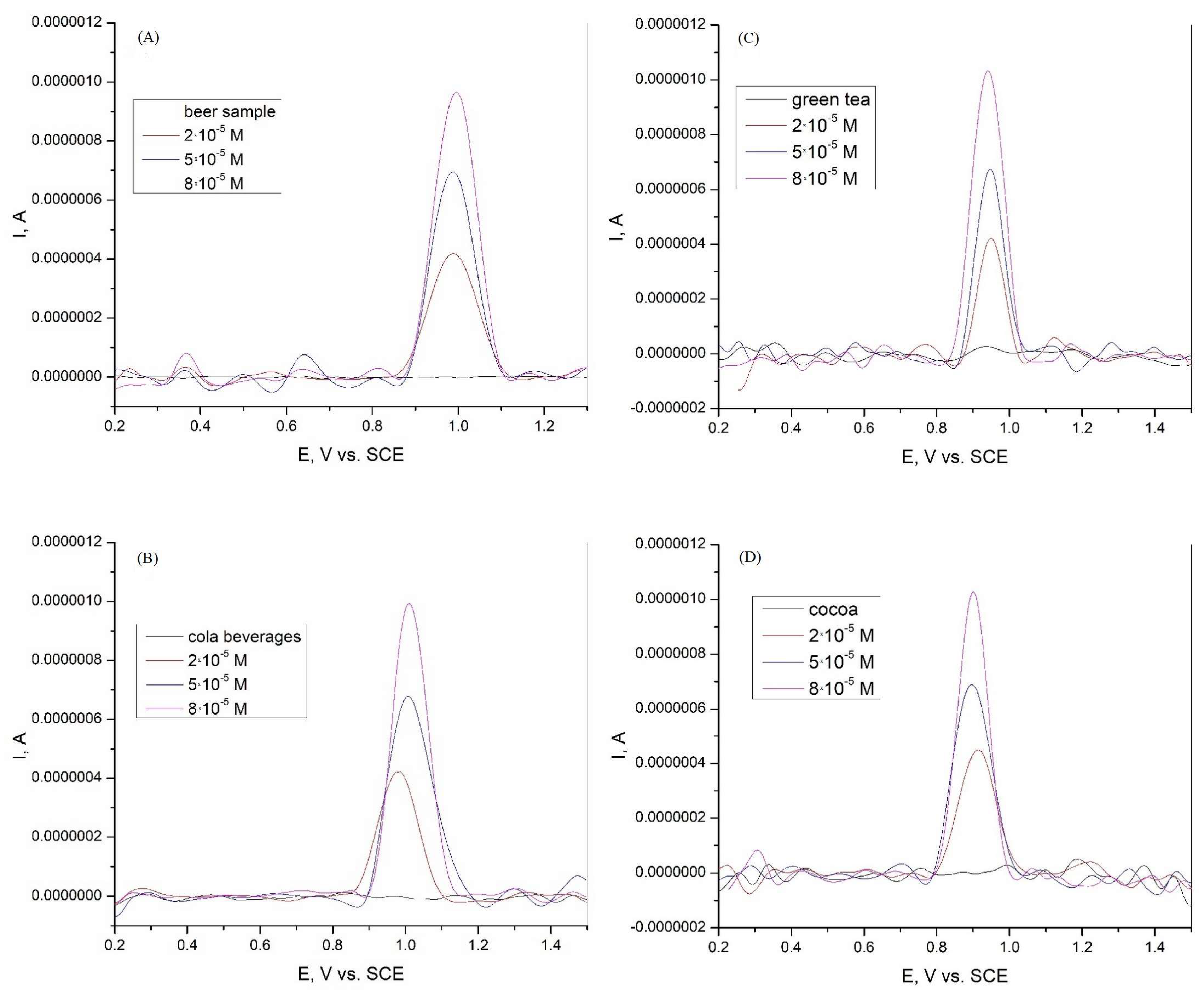
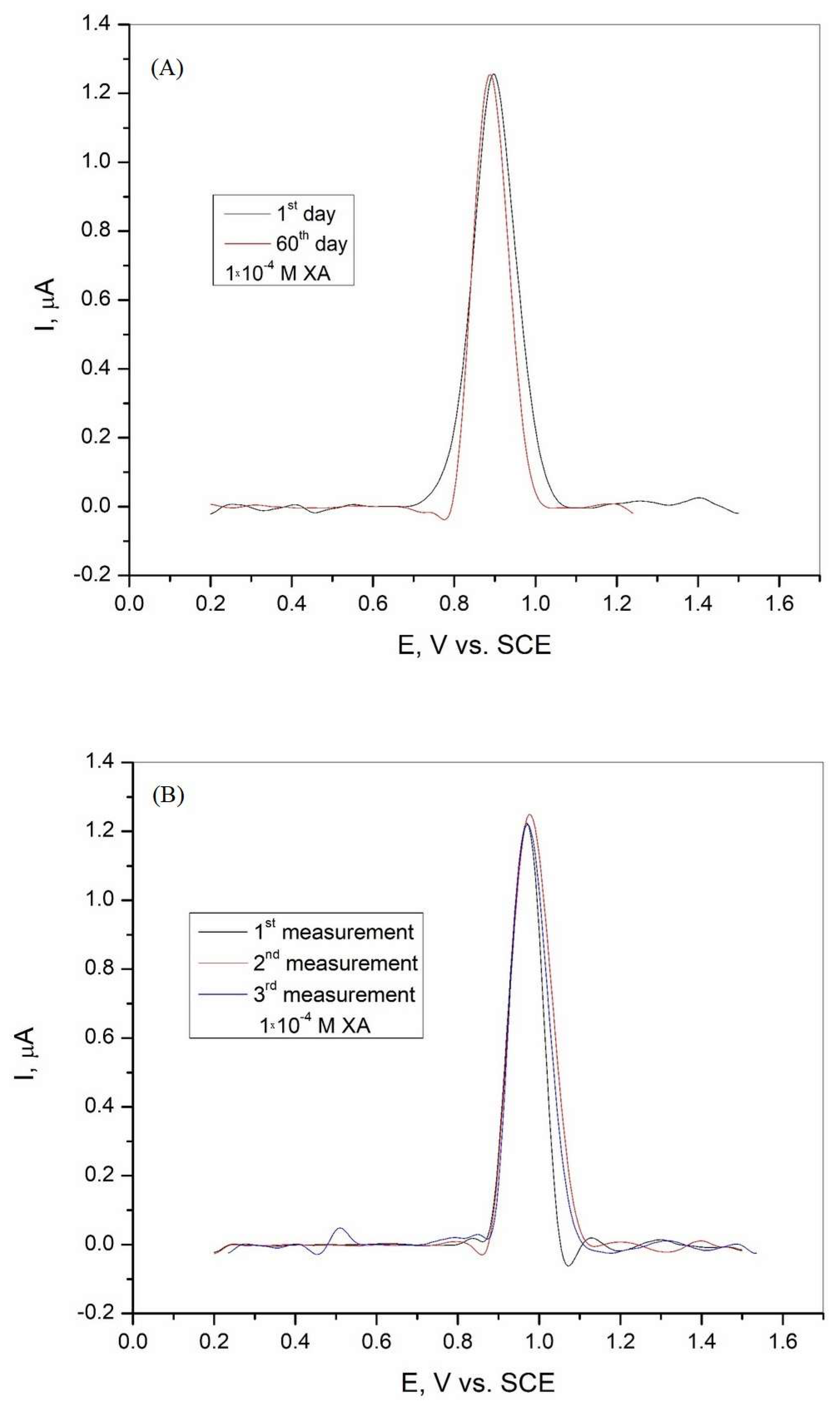
| Sample | Added XA (μM) | Found XA (M) | Recovery (%) | RSD |
|---|---|---|---|---|
| Beer | 2·10−5 | (2.02 ± 0.011)·10−5 | 99.1 | 2.55 |
| 5·10−5 | (4.95 ± 0.057)·10−5 | 101.0 | 0.82 | |
| 8·10−5 | (8.06 ± 0.014)·10−5 | 99.2 | 1.39 | |
| Cola drink | 2·10−5 | (2.03 ± 0.018)·10−5 | 98.5 | 4.23 |
| 5·10−5 | (4.91 ± 0.022)·10−5 | 101.8 | 3.04 | |
| 8·10−5 | (8.01 ± 0.052)·10−5 | 99.8 | 5.05 | |
| Green tea | 2·10−5 | (2.06 ± 0.047)·10−5 | 97.1 | 9.87 |
| 5·10−5 | (5.09 ± 0.066)·10−5 | 98.2 | 9.80 | |
| 8·10−5 | (8.12 ± 0.074)·10−5 | 98.5 | 7.02 | |
| Cocoa | 2·10−5 | (2.05 ± 0.017)·10−5 | 97.6 | 3.76 |
| 5·10−5 | (4.97 ± 0.024)·10−5 | 100.6 | 3.34 | |
| 8·10−5 | (7.9 ± 0.042)·10−5 | 101.3 | 4.08 |
Disclaimer/Publisher’s Note: The statements, opinions and data contained in all publications are solely those of the individual author(s) and contributor(s) and not of MDPI and/or the editor(s). MDPI and/or the editor(s) disclaim responsibility for any injury to people or property resulting from any ideas, methods, instructions or products referred to in the content. |
© 2025 by the authors. Licensee MDPI, Basel, Switzerland. This article is an open access article distributed under the terms and conditions of the Creative Commons Attribution (CC BY) license (https://creativecommons.org/licenses/by/4.0/).
Share and Cite
Radovanović, M.B.; Simonović, A.T.; Petrović Mihajlović, M.B.; Tasić, Ž.Z.; Antonijević, M.M. Application of Graphite Electrodes Prepared from Waste Zinc−Carbon Batteries for Electrochemical Detection of Xanthine. Chemosensors 2025, 13, 282. https://doi.org/10.3390/chemosensors13080282
Radovanović MB, Simonović AT, Petrović Mihajlović MB, Tasić ŽZ, Antonijević MM. Application of Graphite Electrodes Prepared from Waste Zinc−Carbon Batteries for Electrochemical Detection of Xanthine. Chemosensors. 2025; 13(8):282. https://doi.org/10.3390/chemosensors13080282
Chicago/Turabian StyleRadovanović, Milan B., Ana T. Simonović, Marija B. Petrović Mihajlović, Žaklina Z. Tasić, and Milan M. Antonijević. 2025. "Application of Graphite Electrodes Prepared from Waste Zinc−Carbon Batteries for Electrochemical Detection of Xanthine" Chemosensors 13, no. 8: 282. https://doi.org/10.3390/chemosensors13080282
APA StyleRadovanović, M. B., Simonović, A. T., Petrović Mihajlović, M. B., Tasić, Ž. Z., & Antonijević, M. M. (2025). Application of Graphite Electrodes Prepared from Waste Zinc−Carbon Batteries for Electrochemical Detection of Xanthine. Chemosensors, 13(8), 282. https://doi.org/10.3390/chemosensors13080282







